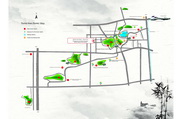
Shanghai cuisine
( meet-in-shanghai )
Updated: 2022-01-04
|
|||||||||
Shanghai cuisine, also known as Hu cai, is a popular style of Chinese cuisine.
Shanghai does not have a definitive cuisine of its own, but refines those of the surrounding provinces (mostly from the adjacent Jiangsu and the coastal provinces of Zhejiang). The use of alcohol is distinct to Shanghai cuisine. Fish, eel, crab, and chicken are swamped with spirits and are briskly cooked, steamed or even served raw. Salted meats and preserved vegetables are also commonly used to spice up the dishes.
The use of sugar is common in the Shanghai cuisine, especially when used in combination with soy sauce, it effuses foods and sauces with a taste that is not very sweet but rather savory. Non-natives tend to have difficulty identifying this usage of sugar and are often surprised when told of the "secret ingredient." The most notable dish of this type of cooking is "sweet and sour spare ribs" ("tangcu xiaopai" in Mandarin).
A popular style of stewing meats and vegetables in Shanghai is known as "Red cooking".
"Beggar's Chicken" is a legendary dish that originated in Beijing, while in the Shanghainese dialect it is known as "jiaohua ji", the dish is wrapped in lotus leaves and covered in clay. Though usually prepared in ovens, the original historic preparation involved cooking it in the ground. The Lion's Head Meatball and Shanghai-style Nian Gao are also uniquely Shanghainese, as are Shanghai fried noodles, a regional variant of chow mein that is made with a thick Shanghai styled noodle. Other popular foods in Shanghai include thousand-year eggs (flavored with lime and ginger) and stinky tofu.
Seafood in Shanghai is also very popular, due to it facing the East China Sea. However, due to its location among the rivers, lakes, and canals of the Yangtze Delta, locals favor freshwater produce just as much as saltwater products like crabs, oysters and seaweed. The most famous local delicacy is the Shanghai hairy crab.
People in Shanghai are known to eat in delicate portions (a reason why the other Chinese often mock them) and hence the servings are usually quite small. For example, the famous buns from Shanghai such as the xiaolong mantou (known as xiaolongbao in Mandarin) and the shengjian mantou are usually about four centimeters in diameter, much smaller than the typical baozi or mantou found elsewhere in China.
Due to the rapid economic growth of Shanghai and its development into one of the foremost East Asian cities as a center of both finance and contemporary culture, the future of Shanghai cuisine looks very promising.
Unlike Cantonese or Mandarin cuisine, Shanghainese restaurant menus will sometimes have a dessert section.
Official Website of the Sheshan National Tourist Resort, Shanghai


